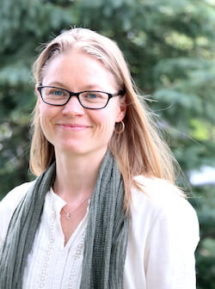Public radio newsrooms that have ramped up reporting on climate change are finding new ways to help their audiences understand the local impact of an urgent and complicated global news story.

Over the last three years, NPR and several member stations have launched special initiatives and created newsroom roles that are dedicated to producing ongoing coverage of climate impacts and solutions.
“Public radio is uniquely positioned to cover climate change in the way it needs to be covered, from daily news to deeply reported enterprise and investigative pieces,” said Joe Wertz, climate and environment editor at Colorado Public Radio. “I think public radio in a lot of ways is leading the way in covering climate change as a local issue.”
CPR received a $1.2 million grant in 2019 to create a Climate Solutions Team of three reporters and an editor who cover climate issues in Colorado. The specialized reporting unit is part of the network’s larger strategy to expand its newsroom.
Funders and audiences alike have recognized the need for dedicated climate coverage that goes beyond reporting on extreme weather. Last year, NPR brought on an additional climate reporter and hired Neela Banerjee as its first supervising climate editor.
“This position exists because our audience told us they wanted more climate coverage and funders agreed,” Banerjee said.
Across varied communities and station sizes, some experiences are common. Here are five key takeaways about covering climate from public media reporters and editors working on new projects or in new roles.
1. Public media listeners and donors want more climate stories
David Boraks, a WFAE reporter who began covering climate full-time in July, said he received immediate and overwhelmingly positive feedback from listeners.

“I have one neighbor who … said, ‘I’m really glad you’re doing this. I’m so worried and I feel powerless and I want to know what to do,’” Boraks said.
The Charlotte, N.C., station received a grant from the 1Earth and Salamander Funds to support a full-time climate reporter for a year, with the possibility of renewing for a second term.
WFAE aired a 30-second spot telling listeners about the new climate reporting position and asked them to share story ideas and questions by completing an online form. Many people wrote that they wanted to learn more about electric vehicles and charging stations.
“I want to do some of the really basic things, like help people understand some question that they worry is a stupid question,” Boraks said. “But there aren’t any stupid questions about this. They want to learn about all the conflicting information. … I hope to be one of the sources on the internet that people will go to that they can trust.”
Adapt, a digital magazine from WJCT in Jacksonville, Fla., has built a loyal and growing audience since the station started publishing it in 2019. The Adapt newsletter, which launched last year, now has over 1,000 subscribers.
“Adapt definitely doesn’t get as many reads or looks as the WJCT website does, but the people who go there … consistently spend much more time on the website,” said Brendan Rivers, lead reporter for Adapt. “It’s a small but consistently growing fan base that is very supportive, and they share our content and they engage with us a lot.”

At New Hampshire Public Radio, audience engagement has translated into donor dollars through fundraising campaigns centered around environmental reporting initiatives. The station launched its climate reporting and audience engagement project, By Degrees, last year and has produced an environmental news podcast, Outside/In, since 2015.
“The station has found [climate change coverage] to be a very powerful fundraising message,” NHPR Managing Editor Cori Princell said. “A lot of station donors really care about the topic and want to do something about it. And they’re happy to support that, and they’re glad to hear the coverage.”
2. Climate change is a local and regional story
NHPR environmental reporter Annie Ropeik said that few media outlets in New England are consistently covering the impact of climate change on the region, and even fewer are telling stories specific to New Hampshire. In many markets, public radio stations are some of the only outlets where news consumers can find climate stories that focus on local issues and trends.
WFAE COO Ju-Don Marshall pointed out that North Carolina communities will experience disparate climate impacts, but residents may lack reliable sources of information about how shifting weather patterns or rising sea levels affect their lives.
“So much of what we see as an outgrowth of the climate crisis happens on the shores, it happens in the forest, and North Carolina goes from the beaches to the mountains,” Marshall said. “I think our residents are really affected by it and don’t have enough information about it.”

In Jacksonville, Rivers said that when WJCT decided to develop its digital magazine, one reason for choosing to focus on climate change was “a gap in coverage” by other local news media.
“I think public media is really kind of taking a leadership position, especially when it comes to local climate journalism,” Rivers said. “It’s great that all these national outlets are doing a lot of climate reporting now, but I think it’s more important for local outlets to do it.”
“Most people accept that climate change is happening, that humans are causing it, but they think of it as kind of a far-off problem that’s not going to affect them or their families or their community,” Rivers said. “And that’s where local media organizations come in, because we can actually show people that this is happening now where you live.”
3. Collaboration is key — internally and externally — for capacity-building and high-impact coverage.
Public radio’s journalism collaborations give stations an advantage in covering complicated and far-reaching climate stories, Ropeik said. NHPR works with nine other public media stations in the region as part of the New England News Collaborative.
For Earth Day 2021, NENC featured a collection of climate change stories from its member stations. The project dovetailed with a global effort organized by Covering Climate Now to support climate stories during the week before Earth Day. Founded in 2019 by Columbia Journalism Review and The Nation in association with The Guardian and WNYC in New York City, the organization works to connect newsrooms with experts and resources for producing science-based climate reporting.
CCNow has more than 460 partner newsrooms, including international news agencies, major daily newspapers, CBS News and NBC/MSNBC. Public media partners include PBS NewsHour, Democracy Now and stations in at least six major markets. The organization holds climate science briefings, recommends sources and works directly with newsroom leaders to implement best practices.
“We work behind the scenes with [journalists], and we also do public events … to help them basically raise their climate confidence and their climate competence so that they feel like they know enough to tell the story authoritatively,” said Executive Director Mark Hertsgaard. “For public stations, oftentimes they don’t have the internal capacity on climate change that they need.”
Public stations are also participating in the Local Media Association’s Covering Climate Collaborative, which launched on Earth Day 2021. The project supports local climate reporting and regional collaboration. The 22 participating newsrooms are grouped in regional hubs and include WWNO in New Orleans, WBEZ in Chicago, New Mexico PBS, Southern California Public Radio, WJCT and WRKF in Baton Rouge, La.
“It’s a complicated topic, and you can do a lot more with multiple people than one,” Boraks said. “And let’s face it, I’m one person at our station. I can do the kinds of stories that one person does. But joining a collaboration immediately multiplies the number of reporters that you have on the story and allows for division of labor.”
Last year WJCT and WFAE participated in a regional collaboration organized by Inside Climate News that focused on stories about local climate initiatives. Rivers said that such projects allow small stations like WJCT to engage with wider audiences interested in climate change.
Recent efforts to boost climate change coverage have also focused on collaboration within newsrooms. At NPR, Banerjee leads a team of four climate reporters on the science desk but also spends significant time collaborating with reporters and editors throughout the newsroom. She works closely with national Energy and Environment Editor Jennifer Ludden, and they hold weekly climate team calls with an “open-door policy” inviting anyone to join.
“I sit on the science desk,” Banerjee said. “But the idea behind creating the supervising climate editor job is to deepen the understanding that climate change is not just a science story. … It is permeating every aspect of our lives now, right? Climate change is a human health story. It’s a political story. It’s an economic story.”
To help journalists who aren’t on the science desk feel more comfortable writing about climate change, Banerjee, Princell and Wertz provide basic climate science resources and training, facilitate partnerships between climate reporters and others throughout their newsrooms and develop prewritten language about climate change that can go into stories about weather events.
“That’s got to be the goal for every newsroom — to make this beat about more than just one person, or one person and their editor, and demystify it for other journalists,” Ropeik said. “I think that is happening here [at NHPR] slowly but surely.”
4. Climate coverage lends itself to digital storytelling.
Several newsrooms have taken digital-first approaches for their climate coverage initiatives by producing interactive web stories, podcast series and magazine-styled websites like Adapt.
“We’ve kind of explored a bunch of different ways of telling these stories with Adapt,” Rivers said. “We’ve done video stories. We’ve done a miniseries podcast. We have this regular newsletter.”
At WFAE, Boraks plans to use a variety of formats on air and online to reach audiences with climate information, including long-form web features, a newsletter and appearances on FAQ City, the station’s online, broadcast and podcast series devoted to answering listener questions.
“Increasingly, public radio outlets — and we are radio stations and we are websites and we are podcasts, we are all kinds of media now that we never used to be — are the place that people turn for fair, extended coverage of topics,” Boraks said. “We have the ability, unlike some other news outlets, to go long on a story.”
NPR has used digital media to “leverage the visual potential of climate stories,” with interactive pieces showcasing video and photography, Banerjee said. Reporters from NPR, WABE in Atlanta and NHPR recently collaborated on the digital story United States of Wildfire, about the increasing risk of wildfires in the Southeast, Northeast and Midwest. Produced as part of NPR’s Energy and Environment Collaborative, the story combined pictures, videos and data visualizations with limited text.
“NPR’s recognized that, especially because of the pandemic, more and more of our audience, especially younger audiences, come to us through digital,” Banerjee said. “We have to maximize digital storytelling when it comes to climate stories.”
Visual elements of digital storytelling also transfer well to social media — particularly Instagram, where Banerjee said NPR connects with more people of color and younger audiences than it finds on Facebook.
Podcasts have also been popular outlets for climate projects launched by radio stations within the past three years. Examples include WJCT’s Adapt series, in which Rivers interviewed six Northeast Florida climate experts, and Wyoming Public Media’s Carbon Valley, which followed the story of a state-sponsored contest to develop carbon-capture technology.
Cooper McKim, host of Carbon Valley and Wyoming Public Media’s natural resources and energy reporter, said that the nine-part podcast series allowed him to explore more of the subject’s complexities and trade-offs than he could have in traditional broadcast reporting.
“Carbon capture was such a controversial subject here in Wyoming,” McKim said. “It’s so confusing when you start getting into, ‘What does it mean if this climate tech is helping keep fossil fuels online?’ … There were so many questions that allowed a longer conversation.”
5. Newsrooms don’t have to create a specialized beat to improve how they report local climate stories.
When Boraks joined WFAE in 2016, he started as an environmental reporter. Over time, though, he found himself picking up other assignments, like police shootings, housing issues and the pandemic.
“I have a long list of story ideas that are related to the environment and climate change that always seem to be the ones that get put aside in favor of these more pressing stories,” Boraks said. “Having a grant-funded position that lets me dedicate full time to the climate beat means that there will be no more pressing issues, that these will be the most pressing issues for us.”
Since CPR added more environmental reporting roles, Wertz said, the team has been able to cultivate sources and tell stories that are deeper and less reactive.

Even without special grant-funded initiatives, Ropeik said newsrooms can improve their climate coverage by providing basic science resources and urging reporters on every desk to include a few lines about climate change whenever it’s relevant to the broader story.
“Literally just stating that climate change is a newsroom priority goes such a long way,” she said. “Don’t forget to mention it when you write about the weather; treat it like you would any other political context or economic context for any other topic. And just make that a rule in the newsroom. That doesn’t take any money. It certainly takes resources to do more enterprise reporting on this topic, but that’s the first step.”
Though climate change coverage has become more mainstream in recent years, there are still shortfalls throughout the American media ecosystem. Hertsgaard of CCNow pointed to a Media Matters analysis of national broadcast reporting on the 2021 Intergovernmental Panel on Climate Change report. Morning and nightly news programs on NBC, ABC, CBS and PBS delivered a combined 22 minutes of airtime Aug. 9, the day the IPCC report was released. Meanwhile, NBC, ABC and CBS dedicated 212 minutes to Jeff Bezos’ space flight July 20.
“That, I think, hints at why public media is so important, because they still believe that the job of the journalist is to tell the public … not what we think the public wants to know, but what the public needs to know to be responsible citizens and informed and empowered citizens,” Hertsgaard said.
"current" - Google News
August 19, 2021 at 08:00PM
https://ift.tt/2XA6Tzr
5 takeaways from the expansion of public radio's climate change coverage - Current
"current" - Google News
https://ift.tt/3b2HZto
https://ift.tt/3c3RoCk
Bagikan Berita Ini














0 Response to "5 takeaways from the expansion of public radio's climate change coverage - Current"
Post a Comment